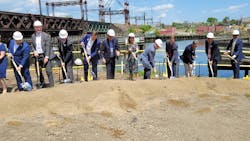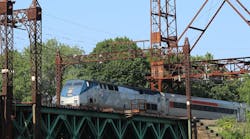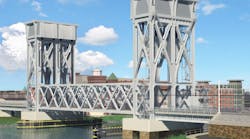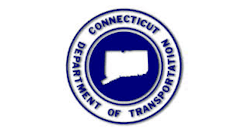CTDOT begins construction on Walk Bridge replacement
Federal, state, regional and passenger rail officials joined together May 12 to mark the start of construction on the Norwalk River Railroad (Walk) Bridge Replacement Project in Norwalk, Conn. The project is part of a larger program that will improve passenger and freight rail movement in Norwalk, with the centerpiece being the replacement of the 127-year-old Walk Bridge.
“The original Walk Bridge was created during the administration of President Grover Cleveland and now, 127 years later during the administration of President Joe Biden, we are replacing it with a modernized bridge that will be strengthened and fully capable of serving the busiest rail line in the nation. This corridor is a critical link for rail travel in the northeast and is essential to supporting economic growth and jobs in Connecticut. This project ticks all the boxes – it helps achieve our goal of faster rail service, reduces traffic on our roadways, promotes economic development and protects environmental and historic preservation,” said Connecticut Gov. Ned Lamont.
The Walk Bridge replacement project will remove the original four-track swing bridge built in 1896 and replace it with a structure that has two independent, moveable spans. The bridge above the Norwalk River will have a 60-foot vertical clearance per the U.S. Coast Guard guidance to meet the river’s reasonable navigation needs.
The Walk Bridge hosted 175 Amtrak, Metro-North and freight trains every day. The Metro-North New Haven Line – the busiest rail in in the U.S. - is owned by Connecticut and maintained by the Connecticut Department of Transportation (CTDOT). The bridge is a key connection to the Northeast Corridor, where any failure results in significant disruption to travel. Upon completion of the replacement project, slow zones on the bridge will be lifted and allow for train speeds that are 15 miles per hour faster.
“Projects like the Walk Bridge are at the heart of what we do. A new Walk Bridge enhances the safety and reliability of rail service, offers operational flexibility and provides for increased capacity, speed and efficiencies of rail transportation along the Northeast Corridor,” said CTDOT Commissioner Garrett Eucalitto.
The project to replace the bridge will not only allow for more dependable rail movements, but the state says the bridge replacement project promotes economic development through infrastructure investment, the protection of potential up-river development and reduced roadway congestion.
“A new, modern Walk Bridge will improve the customer experience by eliminating delays, providing faster journeys and updating critical infrastructure on the nation’s busiest railroad,” said Amtrak CEO Stephen Gardner.
Gardner also expressed gratitude to Gov. Lamont, as well as U.S. Sens. Richard Blumenthal (D-CT), Chris Murphy (D-CT) and U.S. Rep. Jim Himes (D-CT-04), who he called champions of the project.
The $925 million construction project is approximately 80 percent federally funded and 20 percent state funded.
“We greatly value our wonderful partnerships at the federal and state level, including our longstanding relationship with CTDOT. This project will result in better, more reliable service for our customers and represents another step forward in the common pursuit of safe, efficient and sustainable rail transportation that meets the needs of the modern traveler,” MTA Metro-North Railroad President and Long Island Rail Road Interim President Catherine Rinaldi said.
The Walk Bridge replacement project is expected to be completed in 2029.

Mischa Wanek-Libman | Group Editorial Director
Mischa Wanek-Libman is director of communications with Transdev North America. She has more than 20 years of experience working in the transportation industry covering construction projects, engineering challenges, transit and rail operations and best practices.
Wanek-Libman has held top editorial positions at freight rail and public transportation business-to-business publications including as editor-in-chief and editorial director of Mass Transit from 2018-2024. She has been recognized for editorial excellence through her individual work, as well as for collaborative content.
She is an active member of the American Public Transportation Association's Marketing and Communications Committee and served 14 years as a Board Observer on the National Railroad Construction and Maintenance Association (NRC) Board of Directors.
She is a graduate of Drake University in Des Moines, Iowa, where she earned a Bachelor of Arts degree in Journalism and Mass Communication.





